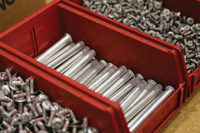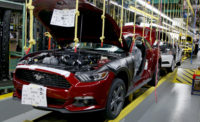We’ve all heard the adage that the three most important things in real estate are location, location, location. When it comes to product labeling and advertising, particularly “made-in-the-USA” claims, the three most important considerations are substantiation, substantiation, substantiation.
An understanding of Federal Trade Commission (FTC) guidelines and California’s recently amended law governing made-in-the-USA claims is critical to avoid becoming the next defendant in the rash of false advertising lawsuits sweeping the country. Consumers who bring false advertising lawsuits, which are often filed as class actions, allege that they either would not have purchased the product (and thus are entitled to a refund of the full purchase price) or would not have paid as much for the product (and thus are entitled to the difference of what it is actually worth and what they paid) had it not been falsely advertised. Consumer protection advocates claim that these lawsuits serve to keep manufacturers honest in their advertising. Critics and advocates for legal reform argue that these lawsuits primarily benefit the lawyers who bring them. No matter what side of the fence you reside in that debate, there is no denying that it is best to avoid these suits.
Some manufacturers believe that a product may be marketed as made in the USA provided it is manufactured in the USA. This is a mistake. Under FTC’s guidelines, a manufacturer choosing to make an unqualified made-in-the-USA claim may do so only if the product is “all or virtually all” made in the USA, meaning that all significant parts and processing that go into the product are of domestic origin. The product should contain no or negligible foreign content. A manufacturer making a made-in-the-USA claim must have “competent and reliable evidence” to demonstrate that the product is all or virtually all made in the USA, including proof that its final assembly or processing occurred in the USA.
Other factors to consider are how much of the product’s total manufacturing costs can be assigned to domestic parts and processing and whether the foreign content is a direct part of the finished product. To determine the percentage of domestic content, manufacturers should look back far enough in the manufacturing process and conduct a trace-back analysis to ensure that foreign content has been included in their assessment of foreign costs. Manufacturers should also obtain written confirmation from suppliers regarding the origin of their products and maintain records to defend against any false advertising claims.
Manufacturers of products that do not meet the criteria for unqualified claims may nevertheless make “qualified” country of origin claims—such as “Manufactured in the USA with domestic and imported parts”—provided there is significant domestic content or processing. Like unqualified claims, qualified claims must be truthful, substantiated and not misleading.
Products sold in California—the only state to specifically regulate made-in-the-USA labeling claims—must also comply with California’s made-in-the-USA labeling law, which was recently amended to align it more closely with the FTC’s guidelines. The amended law allows a product to be labeled as made in the USA provided the foreign content represents 5 percent or less of its “wholesale value.” Further, the law allows made-in-the-USA claims to be used if the foreign content is up to 10 percent of the product’s wholesale value, provided that the foreign content cannot be produced or sourced in the USA, irrespective of cost.
Unfortunately, California’s made-in-the-USA labeling law neither defines wholesale value nor provides any method by which it should be calculated. However, manufacturers may look to the “CA-Made Wholesale Value-Added Formula” associated with the state’s made-in-California law for guidance on how to calculate wholesale value. That formula defines wholesale value to include “direct material cost, direct labor cost, and overhead (indirect material and indirect labor costs).” Thus, before labeling products that may be sold in California as made in the USA, manufacturers should determine whether they fall within the law’s 5 percent or 10 percent thresholds.
Richard Barber, a certified public accountant at L.H. Frishkoff & Co., says that where inconsistencies or questions exist, manufacturers should consider employing accepted accounting principles to determine the wholesale value of their products. Also, manufacturers should be mindful that wholesale value is not a static calculation and can change with fluctuations in labor and material costs. Thus, manufacturers should have a procedure in place to reassess their compliance with the law based upon changes in market conditions.
Adherence to FTC guidelines and California law will serve to mitigate the risk of consumer-driven lawsuits. Nevertheless, given the ever-increasing competitive business environment, some manufacturers may consider offensively challenging competitors’ marketing claims by filing lawsuits against them. However, such lawsuits are not without risk and almost always spark retaliatory counterclaims and tag-along consumer-driven lawsuits. Thus, before filing claims against competitors, manufacturers should ensure that their own house is in order and that all representations used on their product packaging and in advertising are fully defensible against counterclaims and consumer lawsuits. Manufacturers bringing such claims should also be mindful that compliance with governing guidelines and laws mitigates, but does not insulate them from, frivolous lawsuits that could cost tens, if not hundreds, of thousands of dollars to defend against.
Substantiation of made-in-the-USA and other labeling and advertising claims is essential. While the process of substantiation can be arduous, it represents a valuable investment in the future of your organization. Some may say it’s a better investment than real estate.
Unfortunately, because California’s made-in-the-USA labeling law was recently amended, case law demonstrating the evidentiary proof needed to substantiate a country of origin claim and prevail in a false advertising suit has not yet developed. Because many of these suits are brought as class actions, it is important to engage counsel familiar in defending class action lawsuits, as many of these cases fail at the class certification stage.
For example, a federal court judge denied class certification in Picus v. Wal-Mart Stores Inc., a case in which Cozen O’Connor was involved. In that case, the plaintiff claimed that Wal-Mart’s Ol’ Roy brand pet food was falsely labeled as made in the USA because it contained ingredients manufactured in China. In granting the defendants’ motion to deny class certification, the court held that to certify a class, each class member would have to demonstrate that the made-in-the-USA label actually caused him to purchase the pet food. The court reasoned that because “the choice to purchase Ol’ Roy products could be based on a variety of factors unrelated to the ‘made-in-the-USA’ label, such as price, convenience, or a pet’s preference for the product,” this could not possibly be done on a class-wide basis, thereby forcing the defendant to litigate her claim on her own and not on behalf of a nationwide class of consumers. And because these types of cases generally have nominal value to an individual consumer, the matter was disposed of quickly.








